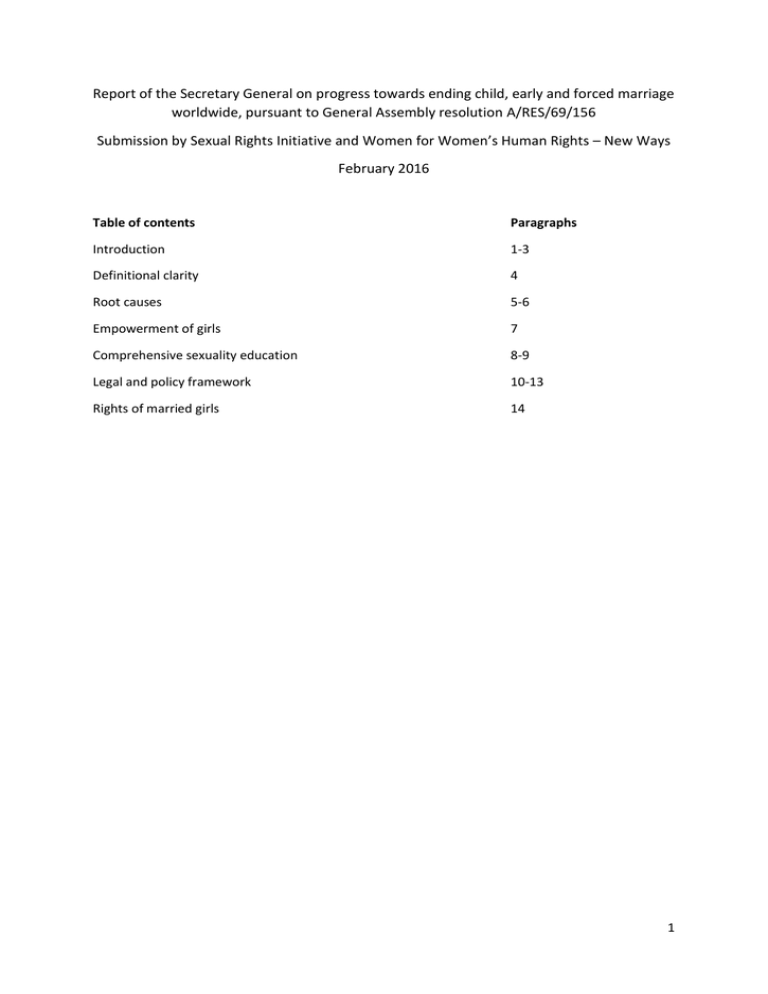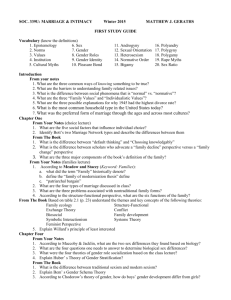
Report of the Secretary General on progress towards ending child, early and forced marriage
worldwide, pursuant to General Assembly resolution A/RES/69/156
Submission by Sexual Rights Initiative and Women for Women’s Human Rights – New Ways
February 2016
Table of contents
Paragraphs
Introduction
1-3
Definitional clarity
4
Root causes
5-6
Empowerment of girls
7
Comprehensive sexuality education
8-9
Legal and policy framework
10-13
Rights of married girls
14
1
Introduction
1. The Sexual Rights Initiative (SRI) coalition was created in 2006. Its aim is to create a political
space for advocacy on sexual rights by bringing together feminist, LGBTI, southern and
northern perspectives and incorporating diverse views without privileging particular
experiences. The coalition partners are Action Canada for Sexual Health and Rights, CREA
(India), Akahata (Latin America), Coalition of African Lesbians, the Polish Federation for
Women and Family Planning, and the Egyptian Initiative for Personal Rights.
2. Women for Women’s Human Rights (WWHR) – New Ways was founded in 1993 with the aim
of promoting women’s human rights in Turkey and on the international level. In 2001, it
initiated a network of NGOs and academics advocating for sexual and reproductive health
and rights as human rights in Muslim societies, the Coalition for Sexual and Bodily Rights in
Muslim Societies (CSBR). Through two decades of activism, advocacy and lobbying, WWHR –
New Ways has contributed significantly to various legal reforms in Turkey, networking in
Muslim societies and promotion of women’s human rights at the United Nations (UN) level.
3. SRI and WWHR make this submission in relation to the report of the Secretary General on
progress towards ending child, early and forced marriage. This submission highlights some
key considerations for policy making and programme development (paragraphs 4-6), as well
as priorities (paragraphs 7-14).
Definitional clarity
4. Forced marriage refers to a union where at least one person did not give free and full
consent. Early marriage has been interpreted to include the marriage of persons aged below
18 years and could be read to include other factors that would make a person unready to
consent to marriage, including the individual’s level of physical, emotional, sexual and
psychosocial development, educational and other aspirations, and lack of information
regarding the person’s life options. When considered in relation to evolving capacities of the
child, it could also be read to mean that a mature, capable individual below the age of 18
should be allowed to marry, provided that the choice is made willingly and free of coercion.
For these reasons, a focus on early and forced marriage is preferable. However, even now
“child marriage”, “early marriage” and “forced marriage” are often used interchangeably. A
breakdown of the definition of the three terms would be extremely useful in not only in
policy and programming, but also in understanding specific redressal mechanisms for
women and girls.1 Further, this breakdown would aid in recognising conceptually and
practically the ‘evolving capacities’ of adolescents and youth.
1
More information regarding definitional clarity between these terms can be found in the submission by SRI and WWHR to
the Office of the High Commissioner of Human Rights titled “Sexual Rights Initiative & Women for Women’s Human Rights
– New Ways submission regarding preventing and eliminating child, early and forced marriage”, available at
http://www.ohchr.org/Documents/Issues/Women/WRGS/ForcedMarriage/NGO/SRI_WWHR.doc
2
Root causes
5. Child, early and forced marriage, like all other human rights violations, does not occur in
society in vacuum. It is a manifestation of societal structures and deeply entrenched
stereotypes related to sexuality and gender. In societies where gender inequality and
discrimination are deeply entrenched, and affect the quality of life of girls and women
throughout their life cycle, child and early marriage is but one such phenomenon that
negatively impacts their lives. Unless fundamental issues related to autonomy, choice and
equity are addressed, a narrow focus on age at marriage will not help tackle the problem.
The lack of bodily autonomy and ability to make decisions with regard to their lives results in
girls being forced into situations they have not chosen, either by their families or by
employers or others.
6. Further, the policy measures are generally geared for prohibition and not prevention. A
preventive approach would address the root causes of child, early and forced marriage, and
is a long term strategy. This strategy would necessarily mean addressing gender
discrimination in a society and understanding child, early and forced marriage as one of the
human rights violations in the life cycle of women. Hence, the first step to address it is to
understand and address the various societal structures that comprise the root causes of the
practice, including but not limited to gender, sexuality and economic structures.
Empowerment of girls and young women
7. Making the empowerment of girls and young women a priority for policy making and
programme development is key to addressing child, early and forced marriage. Policy and
programmatic interventions must recognise the agency of adolescents as a guiding principle
and thus be adolescent-centric. For example, this includes ensuring that adolescents are able
to access good quality formal and non-formal education services, acquire life skills and legal
literacy, organise and mobilise as they choose. This also requires a critical approach to social
systems and structures that oppress based on gender, sexuality, class, race, ethnicity, ability
and other factors. Critically, it requires interventions that challenge the centrality of
marriage for young people, particularly girls and young women, and create space for the
development of alternative life aspirations for adolescents and youth.
Comprehensive sexuality education
8. The provision of comprehensive sexuality education is a critical intervention to empower
adolescent girls, and thus contributes to preventing child, early and forced marriage.
Further, adolescents’ right to access sexuality education is recognized as a basic human right
in both the annual report of Special Rapporteur on the right to education to the UN General
Assembly in 2010 and General Comment No. 4 of the Committee on the Rights of the Child.
3
UNESCO’s guidelines2 are a valuable resource for States for designing sexuality education
programmes.
9. Effective sexuality education must go beyond biology to educate children and adolescents
about gender equality, healthy and positive aspects of sexuality, relationships, gender-based
and sexual violence, sexual and gender diversity, healthy emotive processes, informed
consent and human rights. It should promote empowerment and autonomy by including
structured opportunities for adolescents to practice life skills they will need to be able to
make free and informed choices about their sexual lives and to explore their attitudes and
values. Such education must be free of and aim to eliminate stereotypes, discrimination, and
stigma; respect the evolving capacities of children and adolescents; and be tailored to meet
the specific needs of particular groups. The topic of child, early and forced marriage should
be addressed from a gender perspective and in a culturally relevant manner.
Legal and policy framework
10. Legal and policy frameworks on child, early and forced marriage necessarily should be
centred on the rights of persons most affected, i.e. women and girls. More specifically, legal
and policy frameworks should create enabling conditions for women, girls, and all young
people to have the autonomy capacity to say no to marriage if they are being forced to
marry, and to have the support systems wherein their decision is not further stigmatised. In
this context, one cannot overemphasise the need for laws and policies to be preventive.
11. It would not be incorrect to say that the current prevailing trend and focus in relation to
legal and policy frameworks are to prohibit marriages and criminalise. This approach fails to
take note that in most forced marriages, the culpable parties are the family members of the
child. Penalising these family members – in many cases the only earning member of the
family – further marginalises families and stigmatises children within their own family.
12. As previously mentioned, practices such as child, early and forced marriage do not happen in
isolation, and the realities of other laws and policies impacting young people cannot be
ignored. Laws relating to the criminalisation of the sexuality of young people leave them
with only one option to experience their sexuality without being penalised, i.e. marriage. In
contexts such as this the reasons for early marriages are manifold, and legal and policy
frameworks should not address only the symptoms.
13. Further, the policy framework towards empowerment of women and girls should be holistic.
They cannot aim only to reach numbers but should be aspirational. For example, the
objective of education for young girls should be to create opportunities and increase their
independence as opposed to increasing literacy levels for the nation.
2
UNESCO. International Guidelines on Sexuality Education: An evidence informed approach to effective sex, relationships and HIV/STI
education. 2009, available on-line.
4
Rights of married girls
14. While addressing child, early and forced marriage, the rights of married girls should be
ensured. Child, early and forced marriage results in a continuum of harm through the life
cycle of women and girls. Hence, the rights of women and girls who are married, and their
empowerment, necessitate a distinct strategy, including housing, economic empowerment,
education etc. The specific sexual and reproductive rights and needs of married women and
girls should be ensured. Further, legal measures to leave marriages, divorce, maintenance,
and inheritance should be made equitable towards men and women to ensure that women
and girls who want to leave forced marriages are able to do so without further
stigmatisation.
5




